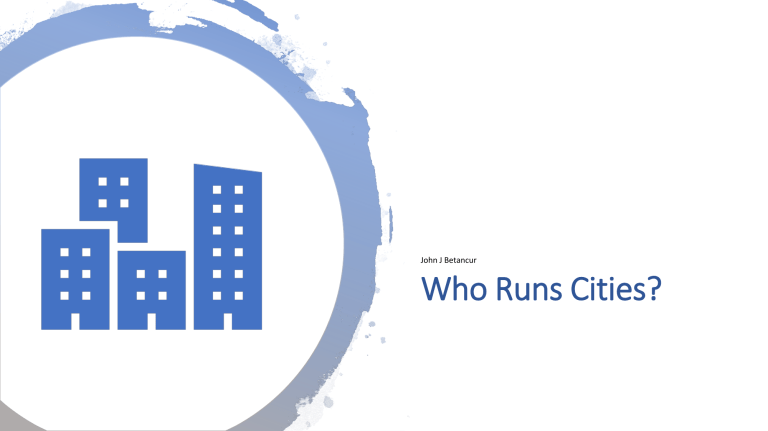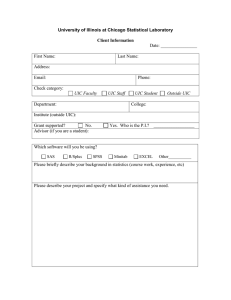
John J Betancur Who Runs Cities? Today • Political economy studies economic, political, social and other factors and forces as pieces of the same puzzle. Accordingly, it studies urban government at their confluence differentiating among historical formations of politics and economics through the concepts • Urban regimes • Urban Machines and • Growth Coalitions Most people would say, Mayors and City Councils Who Runs Cities? Not so fast! As capitalism changes so do cities and their governing Dominant Actors/ Concentration of Power Primary Goals Resources Used Pathways for Influence Growth Machine Theory -Real estate developers. -Top government officials. -City contractors and construction companies. -City newspapers. -Create developments that maximize the economic value of urban land. -Concentrate power among those who favor this objective. -Private money from donors, investors, and development projects. -Political capital from powerful allies. -Planning organizations and hearing boards. -Dominance of media coverage outlets. -“Power of the purse”: ability to purchase land. Pluralist Theory -Power fragmented among a variety of actors depending on policy area. -Non-governmental organizations, local elected officials, and bureaucracy. -Neighborhood and community development groups. -Create a decentralized government with many groups wielding influence on their agenda. -Promote access to disadvantaged groups. -Distribute resources based on need. -Political will from a large group or community with shared interests. -Pooled monetary strength and influence from national organizations with local chapters -Local media attention, press releases, and sometimes national publicity. -Lobbying government officials or protesting decisions through strikes. -Electoral strength because of their large numbers. -Government meetings, boards, or planning agencies. Regime Theory -Usually wealthy business, cultural, and top political actors form a concentrated ruling coalition with mutual goals. -Sometimes other NGOs or actors included. -Maintain the leadership of the urban regime. -Create favorable policies for business growth. -Exclude other groups from having influence. -Top level political decision-making power. -Extensive donor network and control of jobs in the city, economic resources. Mayor’s office and other city government agencies. -Access to elite actors in local media. -Financing of major urban development projects or cultural institutions. Elite Theory -Power concentrated in the hands of one dominant actor who has the power to shape the course of an issue to serve his/her personal objectives. Further personal objectives in a particular issue area. -Maintain a position of power and leave behind a favorable legacy. -Personal reputation and background of power and success (charisma). -Generally can harness all resources necessary, monetary, political, and media, to promote goals -Extensive exposure of goals in local and national media. -Access to and trust of top-level decision-makers and urban power brokers, or being one themselves. -Whatever means necessary to achieve goals; will make any alliances needed. Electoral Theory -Power decentralized, in the hands of millions of voters who can decide who has it. -Power concentrated among elected public officials. -To maintain support of constituency by furthering their objectives and broaden appeal. -To gain re-election and stay in power. -Networks of political party members and donors. -Broader support from national political party. -Money from wealthy donors, businesses, unions, or other groups. -Passing laws and regulations that govern the city. -Appointing public officials and members of bureaucracy. -Public media exposure. -Handing out contracts for city projects. Andrew R. Stevenson. (2007). Elites, Regimes, and Growth Machines: The Politics of Parks Development in Chicago and London, p. 45. Constitutionally speaking… • “The Tenth Amendment leaves establishing local government to state authority: • “The powers not delegated to the United States by the Constitution, nor prohibited by it to the States, are reserved to the States respectively, or to the people.” • Free to organize themselves, states have created municipal sub-divisions such as counties, cities, townships, library boards, and special taxing districts. The relationship of these subdivisions between each other and the state, and the authority each sub-division possesses are subjects of state constitutions and statutes.” • (David J. Shestokas, 2014, The US Constitution and Local Government at http://www.shestokas.com/constitution-educational-series/the-us-constitution-and-local-government/) “City governments, run by mayors or city councils, hold a restricted amount of governing power. State and federal governments have been granted a large portion of city governance as laid out in the U.S. Constitution” Constitutionally… “The remaining power held by individual cities becomes a target of numerous outside [and inside] influences such as large corporations and realestate developers.” (https://en.wikipedia.org/wiki/Urban_politics_in_the_United_States) Differences • Market economics argues that government should follow and defend the market and create the conditions for its smooth functioning • Political economists argue that the market is run by powerful actors coalescing with government to maximize their gains US/UPP/UIC Claim • The US defines itself as a constitutional, representative democracy • Local administrations should be fairly elected and represent the will of residents • Democratically elected governments are expected to balance the interests of the different components of a city • Representative local government has a legislative branch whose charge is to legislate (city council) and an executive body (mayor and cabinet) whose role is to execute Fact • US cities are governed by regimes, growth coalitions, machines and other such arrangements… on behalf of their interests • At times organized around patronage they rely on an electorate that remains loyal if it gets the reward of a job, a contract, a ‘favor’, special privileges… Early on, the creators of towns and cities in the USA were individuals and public officials dedicated to making money out of place-building and “focused on attracting federal investment behind their enterprises (“Jockeying for canals, railroads and arsenals”)” (Logan and Molotch 57) Today, local governments are dedicated for the most part to create ‘good business climates’, that is, environments that prioritize the interests of businesses/secure investor confidence… US/UPP/UIC Historical Trajectory of local government in the USA • “Until the 1930s, the federal government took a laissez faire (hands off) approach to city problems.” (268) • With the Great Depression, the feds got heavily involved in the facilitation of city development. • With the new depression of the 1970s, federal government divested itself asking municipalities to ‘take care of themselves’ and enacting unfunded mandates often. US/UPP/UIC Criticism of Political Economy Explanations “Structural critiques may be … flawed by their functionalism and economic determinism” While emphasizing the mechanisms that generate systemic, cumulative, political inequality, they are accused on neglecting the role of agents and of resistance in the shaping of government. Machines • “Political machine… is a party organization, headed by a single boss or small autocratic group, that commands enough votes to maintain political and administrative control of a city, county, or state. The rapid growth of American cities in the 19th century… created huge problems for city governments, which were often poorly structured and unable to provide services. In those conditions, political machines … were able to build a loyal voter following, especially among immigrant groups” that they compensated with jobs and benefits “offering avenues of mobility at a time when” these were not readily available (Encyclopedia Britannica) https://i.ytimg.com/vi/3XzdltsTfvE/maxresdefault.jpg Chicago’s Democratic Machine • The Chicago growth machine (AKA the Democratic Machine) started as a coalition between the Democratic Party, labor and place-dependent entities (real estate and media principally) that won the 1931 municipal elections and secured its re-election since through a tightly controlled and centralized organization dispensing public jobs and powers in exchange for loyalty and unleashing its might against opponents US/UPP/UIC The Chicago Democratic Machine • Started with Bohemian immigrant Anton Cermak who became mayor in 1931 forcing the democratic “party's dominant Irish contingent to accept other ethnic groups into his “house for all peoples… when Cermak became the unintended victim of an attempted assassination of president-elect Franklin D. Roosevelt” in 1933, the Irish seized control under Edward J. Kelly who doled “out patronage jobs, political appointments, and favors to a broad spectrum of ethnic groups” thanks to the federal largesse of the New Deal, organized crime, and black voters. Replaced by Martin H. Kennelly in 1947, who was defeated by Richard D. Daley in 1955… The democratic party has run the city since with the only exception of 1983-1987 when it was defeated by a Black and Latino coalition with the support of progressive whites. (Encyclopedia of Chicago at http://www.encyclopedia.chicagohistory.org/pages/774.html) http://www.trbimg.com/img-1359497121/turbine/chi-cermak29burial-19991228/480 https://th.bing.com/th/id/R.3f97b44acb6df9d080f39d93be00151 7?rik=TFiZs6WeFrcVEA&riu=http%3a%2f%2fwww.trbimg.com%2f img-55566a7d%2fturbine%2fct-chicago-mayor-rahm-emanuelinaugurate-junk-edit20150515&ehk=GDVeFQXBzsSRbVG7VWfUGkXdRrrwShK95i0GW FWn%2bn0%3d&risl=&pid=ImgRaw&r=0 https://arc-anglerfish-arc2-prodtronc.s3.amazonaws.com/public/O4N7ERU24NFZLF4PRVMAM 5WGUI.jpg https://bloximages.chicago2.vip.townnews.com/effinghamdailynews.com/content/tncms/assets/v3/editorial/b/f5/bf5a243d-9ad0-54b9-85d7-2fc70ac3e331/5aaec1ed96e03.image.jpg Chicago’s Democratic Machine is said • To have produced two presidents, guess who! https://live.staticflickr.com/3022/2636923419_214d1c2c1f_n.jpg https://images.booksense.com/images/932/328/9780809328932.jpg • The Machine’s “influence is seen to often extend even further, to a wide range of allies that variably promote and support the common objective of growth. These include professional sports teams, organized labor, small retailers, corporations, universities and cultural institutions.” The Growth Machine • US/UPP/UIC Rodgers, S. (2009) ‘Urban geography: urban growth machine’ In The international encyclopedia of human geography. R. Kitchin and N. Thrift (eds). Oxford: Elsevier. Volume 12: 40-45. Growth coalitions are the most common forms of local government in the USA Growth Coalitions • Logan and Molotch characterize them as, • growth oriented; • property sector biased/controlled; • supported by an ideology of value-free development; • based on local ‘political entrepreneurship’; • with token representation of other interests. Common Components of Growth Coalitions • Place-based businesses helping elect and control politicians • Global corporations • Politicians • Local media • Utilities • Universities • Museums, theaters, expositions • Professional sports • Organized labor (?) These and other groups coalesce to form governments that represent and help them US/UPP/UIC • Organizations of civil society (?) • Others (???) The Basis of these Coalitions • “Although the growth coalition is based in land ownership, it includes all those interests that profit from the intensification of land use. Thus, executives from the local bank, the savings and loan, the telephone company, the gas and electric company, and the local department store are often quite prominent as well. As in the case of the corporate community, the underlying unity within the growth coalition is most visibly expressed in the intertwining boards of directors among local companies. And, as with the corporate community, the central meeting points are most often the banks, where executives from the utilities companies and the department stores meet with the largest landlords and developers.” (Power at the Local Level: Growth Coalition Theory by W. Domhoff. Who Rules America athttps://whorulesamerica.ucsc.edu/local/growth_coalition_theory.html) • The “Urban regime concept seeks to explain the relationships between elected officials and those influencing their decisions. They include: Urban Regime • Corporate or development regimes promote growth and normally reflect the interests of a city's major corporations while neglecting distressed areas and populations. • Caretaker regimes normally oppose large-scale development projects in fear of increased taxes and of disrupting normal ways of life. • Progressive regimes respond to the needs of lower- and middle-class citizens and environmental groups … • Intergovernmental regimes exist in cities of extreme need that are mismanaged and financially troubled. The governor and state legislators are important regime actors in these cases. • (https://en.wikipedia.org/wiki/Urban_politics_in_the_United_States) Pittsburgh's Allegheny Conference • “Incorporated in 1944, the organization was the result of efforts undertaken by Pittsburgh Regional Planning Association President Richard King Mellon and Carnegie Institute of Technology President Robert Doherty to address obstacles that might impede the economic growth of city. In particular, the Allegheny Conference was concerned that the area’s overreliance of heavy industry and resulting pollution might hinder efforts to attract and retain people and businesses to the area. Early sponsors from the public sector included Pittsburgh Mayor David L. Lawrence and Allegheny County Commissioner John Kane. Over the ensuing decades, the Allegheny Conference has worked to establish Point State Park, consolidate public transit operations, assist minority-owned businesses, and develop Pittsburgh’s Cultural District.” (https://www.heinzhistorycenter.org/detre-library-archives/collectionhighlights/allegheny-conference-community-development) https://www.heinzhistorycenter.org/detre-library-archives/collection-highlights/allegheny-conference-community-development ‘Growth’ has been the magic word of local governments US/UPP/UIC • Supporters argue that “growth strengthens the local tax base, creates jobs, provides resources to solve existing social problems, meets the housing needs caused by natural population growth, and allows the market to serve public tastes in housing, neighborhoods and commercial development.” (Logan and Molotch 85) Ultimately, for Political Economy • “Growth politics is part of the everyday politics that decides who gets what, and where, in cities” (Feagin and Parker 254) US/UPP/UIC US/UPP/UIC • It places demands on public resources negatively affecting the fiscal health of cities Is growth good for cities? • “Local growth does not make jobs… “redistributing the stock of jobs among places may move the chairs around, but it does not alter the number of chairs available to the players” (89) • The benefits of growth do not filter down; indeed, growth tends to accelerate inequality • It tends to have negative consequences on the physical environment Costs of Ongoing Global-Local Agendas Heavy Subsidies to corporations and place-based industries such as construction and entertainment/tourism Gentrification of strategic areas and abandonment of the inner city A global Chicago for the global classes … What about the rest? Corruption • “Chicago has a long history of political corruption, dating to the incorporation of the city in 1833. It has been a de facto monolithic entity of the Democratic Party from the mid 20th century onward. In the book Corrupt Illinois (2015), Gradel and Simpson reports that Chicago and Cook County's judicial district recorded 45 public corruption convictions for 2013, and 1642 convictions since 1976, when the Department of Justice began compiling statistics. This prompted many media outlets to declare Chicago the "corruption capital of America". Tabulating federal public corruption convictions these authors Simpson found that Chicago was "undoubtedly the most corrupt city in our nation", with the cost of corruption "at least" $500 million per year.” • (https://en.wikipedia.org/wiki/Political_history_of_Chicago#:~:text=Chicago%20has%20a%20long%20history%20of%20political%20corruption%2C,Democratic%20Party%20from%20the%20mid%2020th%20century%20onward.) The top 10 most-corrupt cities in the US 1. Chicago 2. Los Angeles 3. New York 4. Washington D.C. 5. Miami 6. Newark, NJ 7. Cleveland 8. Philadelphia 9. Richmond, VA 10. Brooklyn, NY Source: Sun Sentinl, https://www.sun-sentinel.com/features/sfl-top-10-most-corrupt-cities-us-pictures-photogallery.html Criminal Organizations • “Criminal organizations co-exist with lawabiding productive agents and potentially corrupt law enforcers. The crime syndicate obstructs the economic activities of agents through extortion and may pay bribes to law enforcers in return for their compliance in this.” (Blackburn, Neanides an Rana, 2017) Why do Special Interests Seek to Control Government? Subsidies (e.g., taxes, bonds, land and zoning deals) Voter support for projects (or approves them on behalf (??) of voters) Pro-developer policies such as FHA, The 1949 Housing Act and Urban Renewal, CDBGs, UDAGs… Government versus Governance Today’s doctrines promote governance over government While government is understood as the domain of politicians, governance calls for concertation between government, the private sector and civil society around the goals growth and urban competitiveness http://1.bp.blogspot.com/-IetA5zfF5cc/T7ft_E2It3I/AAAAAAAADfg/CCxIFHftsSI/s1600/have_a_nice_day_wallpaper_by_vv0jt3k-d3dg5wc.jpg US/UPP/UIC







